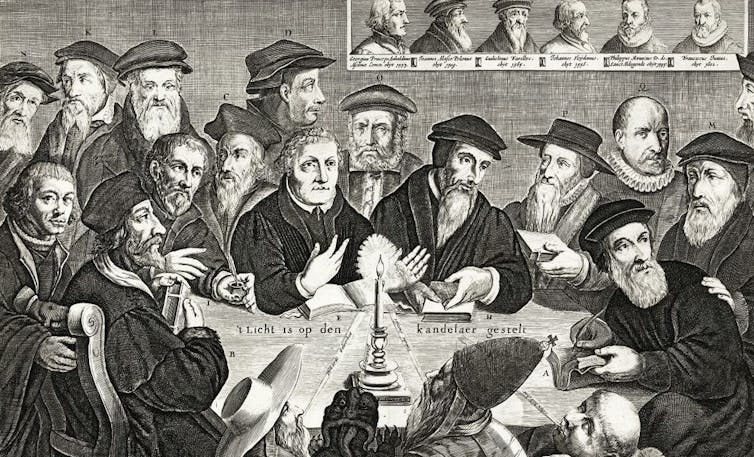
By Gary Z McGee | Self-inflicted Philosophy
1.) Religion claims to have all the answers; spirituality questions all claims:
“People afraid of losing their truth tend to be more violent than people who are used to looking at the world from several different viewpoints. Questions you cannot answer are usually better for you than answers you cannot question.” ~Yuval Noah Harari
Religion is narrow-minded because it believes it has all the answers. Spirituality is open-minded because it dares to question all answers. The simple fact that it is considered blasphemy to question the answers that religion provides, creates a wall for the curious mind. Blocking curiosity leads to a lack of imagination. A lack of imagination leads to stagnant spirituality. And stagnant spirituality is fundamentally unhealthy for human beings.
One may have become religious with the intent to be spiritual, but stagnant spirituality will almost always be the result when one is scared to question things. The only way out of such stagnation is to regain both curiosity and imagination and to continue the spiritual search by questioning all so-called answers. One does not need religion for this task.
2.) Spirituality subsumes all religions while tossing out all dogma:
“In order to shake a hypothesis, it is sometimes not necessary to do anything more than push it as far as it will go.” ~Denis Diderot
No religion is off-limits to a truly spiritual disposition. All religions are subsumed. All dogma is rejected; it is recognized as an existential trap of the most high and most devious. “Spirituality” contained in a little box of fear (religion) is no longer spiritual and has become dogmatic and closed in.
A spiritual seeker is wise to flatten the box of religious dogma and think outside the “one-right-way” influence of certain religions in order to broaden their spiritual comfort zone and strengthen their open-mindedness, empathy, and compassion toward the spiritual capacities of the human condition.
3.) Religion is an outdated search engine; spirituality is an updated search engine:
“Time makes ancient good uncouth.” ~James Russell Lowell
Everything changes. The universe is in constant flux. The only permanence is impermanence. The only thing that doesn’t change is changing itself. Spirituality embraces these facts. Religion attempts to ignore them but does so in vain. Stuck in parochial values, religion is incapable of re-evaluating the search for truth.
Religion is an outdated search engine because it is stuck in the dead patterns of old programming. Religion has given up the search for truth with the audacious claim that it has already found it. Spirituality is a constant, never-ending search for the truth and so it is always at the forefront of the spiritual journey. It is only when a spiritual seeker has pigeonholed their spirituality, and dogmatized it, that they have given up the search and become religious.
True spirituality never closes itself off to the truth no matter how convincing the dogma.
4.) Religion is about blind faith; spirituality is about open-mindedness:
“To choose the course of honesty is to risk the sacrifice of popularity; to choose adventure is to jeopardize security.” ~Guy Claxton
Belief without question is a religious hang-up. To believe something just because a religious authority said so is not spiritual. It is indoctrination at best and brainwashing at worst. The fact that religions require one to have blind faith in such preposterous notions as Flying Spaghetti Monsters and Jewish Zombies is a detriment to spirituality itself. Especially when such claims are considered spiritual by religious zealots.
True spirituality isn’t about belief or faith; it’s about open-mindedness and oneness. It’s about existential flexibility and the ability to take things into deep consideration without the need to place all of one’s “eggs” into any single “basket.”
Religion has “faith” in a destination; spirituality allows the journey to be the thing.
5.) Spirituality is courage-based; religion is fear-based:
“That which can be destroyed by the truth should be.” ~P.C. Hodgell
Pastel’s Wager is an old hat. Fear-conditioning is anti-spiritual. Using fear tactics to bludgeon otherwise well-meaning truth seekers into compliance is the hallmark of traditional religions. True spiritual seekers are beyond such pettiness. They don’t fear God. They are God. They are love. They are one with the interconnectedness of all things (God).
True spirituality is beyond good and evil. It’s about unity with all things. It’s about healthy co-existence. It’s about compassion, openness, empathy, and love. It’s not about fear. It’s not about trepidation and threats of delusional hells and devils and demons and angry vengeful gods. Beware any religion that threatens you with eternal damnation and then has the unmitigated gall to claim it is spiritual.
6.) Spirituality is painful growth; religion is comfortable stagnation:
“I don’t want comfort. I want God. I want poetry, I want real danger, I want freedom, I want goodness. I want sin.” ~Aldous Huxley
Where religion is about comfort and security (placation), spirituality is about honesty and adventure (contemplation).
The adventure of self-discovery, the personal truth quest, is paramount for the spiritual seeker. Without the truth quest, the journey cannot be the thing. The journey comes to an end. Where the spiritual journey ends, religion begins.
A true spiritual seeker never allows the journey to end. There is always something more to learn. God is infinite. There is no end to spiritual growth, barring death itself, and even death puts spiritual growth into perspective.
7.) Religion is codependent; spirituality is interdependent:
“Now I am nimble, now I fly, now I see myself under myself, now a god dances within me.” ~Nietzsche
A religious person is in a codependent relationship with God; they are dependent upon a divine lawgiver for their salvation. A spiritual seeker is in an interdependent relationship with God; they understand that they are a finite aspect of an infinite interconnected whole—the Great Mystery.
As Plutarch said, “The eye with which I perceive God is the same eye with which God perceives me.”
Spirituality is a holistic connection with an interconnected cosmos where universal laws bind everyone. Religion is about holy obedience to a deity declaring divine law. The former is cosmic. The latter is dogmatic.
8.) Religion is reactive intimidation; spirituality is proactive meditation:
“Death destroys man, but the idea of death saves him.” ~E.M. Forster
Fear is not the only way that religion intimidates people; it also uses love and placation as a way to lull the unwary spiritual seeker. Where religion gives you a crutch to limp blindly through faith, spirituality takes the crutch away and forces you to be responsible with your faith. The reactive religious zealot, wallowing in his codependence, is at the mercy of his faith. The proactive spiritual seeker, liberated of dogmatic fetters, is free to question his faith without fear of blasphemy.
Where the religious zealot fears death and God, the spiritual seeker channels such existential angst into a proactive meditation. A spiritual seeker uses death to keep life in perspective through meditation. A religious zealot obsesses over death and the afterlife at the expense of life through self-inflicted intimidation. Religion is fearful while intimidating its members. Spirituality is fearless while liberating all people.
9.) Spirituality allows the Great Mystery to remain great and mysterious:
“The most beautiful experience we can have is the mysterious—the fundamental emotion which stands at the cradle of true art and science.”
Where religion vainly attempts to pigeonhole infinity into a finite concept and call it “God,” spirituality allows infinity to be infinite and calls it The Great Mystery. Where the religious God claims to have all the answers, the Great Mystery trumps it with the almighty question mark. It is vital that both the concept of God and the Great Mystery remain mysterious, lest the organ of our imagination shrivel up and die.
Religion’s God attempts to convince us that we are merely a speck in the universe. The Great Mystery makes it clear: we are the entire universe in a speck. And from our precarious position, we are free to be in awe, overwhelmed, and empowered by the mystery of it all. Religion attempts to steal this mystery from us and package it up in a divine lawgiver, judgmental and void of mystery.
10.) Spirituality speaks a language older than words; religion speaks a language limited by words:
“Stop acting so small. You are the universe in ecstatic motion.” ~Rumi
When it comes down to it, we simply do not know what the Great Mystery (God) is. Anyone, or any group (religion), who claims to know should be met with the utmost credulity and circumspection. Our human language is simply inadequate for the task. The Great Mystery, the interconnectedness of all things, from quarks to quasars, from worms to wormholes, is ultimately ineffable—so profound and intense as to defy description. It speaks a language older than words, a dance older than music. It’s a unifying lifeforce flowing in and through all things, binding the cosmos in an infinitely exploding web of transformative energy. This cannot be explained. It can only be felt.
Religion vainly attempts to explain it all by boxing it up in a sacred text written by fallible men perceiving an infallible universe. Spirituality feels it, flows with it, meditates with it. Spirituality never tries to own it, never claims to know it; for the Great Mystery can neither be owned nor known. The Great Mystery is as much beyond us as it is inside of us. It may not be completely knowable or explainable, it may not even be conceivable, but it can be felt, through the mystery of time, through the mystery of impermanence, through the mystery of consciousness. And it can be interpreted through a language older than words, which isn’t even a language at all, but a unifying force connecting all things. The mistake is trying to trap it, to own it, to use it to control people. Better to simply feel it, flow with it, meditate on it.
People have been mistaking religion for spirituality for far too long. It is high time that we erase this most nefarious confusion. This article is a testament to shining such a light.
About the Author
Gary ‘Z’ McGee, a former Navy Intelligence Specialist turned philosopher, is the author of Birthday Suit of God and The Looking Glass Man. His works are inspired by the great philosophers of the ages and his wide awake view of the modern world. Visit his website: Self-Inflicted Philosophy.
This article (10 Reasons Why Spirituality is Greater Than Religion) was originally created and published by Self-inflicted Philosophy and is printed here under a Creative Commons license with attribution to Gary Z McGee and self-inflictedphilosophy.com.


 Well, it’s true! In fact the oxygen, nitrogen and carbon atoms that are in our bodies were created in stars over 4.5 billion years ago! We are literally made of star stuff. Far…out.
Well, it’s true! In fact the oxygen, nitrogen and carbon atoms that are in our bodies were created in stars over 4.5 billion years ago! We are literally made of star stuff. Far…out. Tamara Rant is a Co-Editor/Writer for CLN as well as a Licensed Reiki Master, heart-centered Graphic Designer and a progressive voice in social media activism & awareness. She is an avid lover of all things Quantum Physics and Spirituality. Connect with Tamara by visiting
Tamara Rant is a Co-Editor/Writer for CLN as well as a Licensed Reiki Master, heart-centered Graphic Designer and a progressive voice in social media activism & awareness. She is an avid lover of all things Quantum Physics and Spirituality. Connect with Tamara by visiting 
 By Karen Noé, renowned psychic medium and author of the Angel Quest Oracle
By Karen Noé, renowned psychic medium and author of the Angel Quest Oracle














